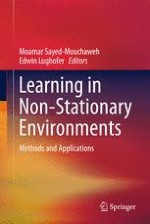2012 | OriginalPaper | Chapter
10. Sequential Adaptive Fuzzy Inference System for Function Approximation Problems
Author : Hai-Jun Rong
Published in: Learning in Non-Stationary Environments
Publisher: Springer New York
Activate our intelligent search to find suitable subject content or patents.
Select sections of text to find matching patents with Artificial Intelligence. powered by
Select sections of text to find additional relevant content using AI-assisted search. powered by
